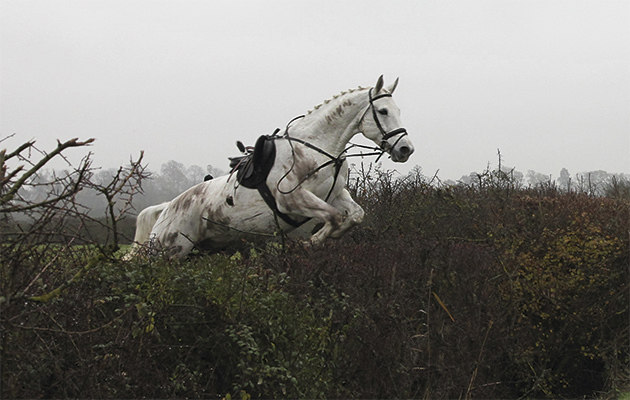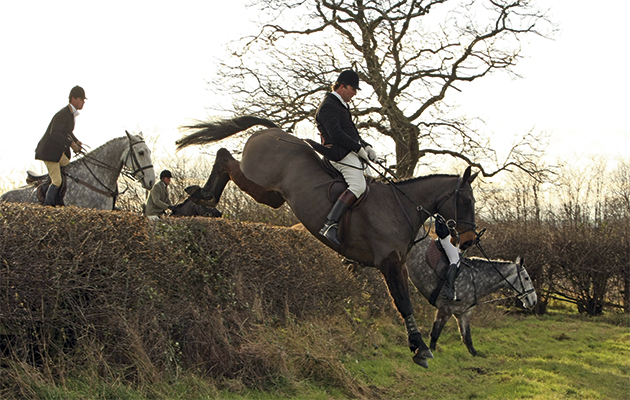The hunting black runs are lines of fences that make you push down your hat when hounds open. Have you survived these monsters? Read on to find in which hunting country they lurk.
Hunting black runs can strike fear into the hearts of the fearless. Talked about in whispers, whooped about in triumph. Which are the hunting black runs that make grown men and women blanch? Sarah Fitzpatrick investigates which famous runs make up the best hunting black runs.
HUNTING BLACK RUNS
One of the great things about hunting is that you don’t get to walk the course. When hounds are screaming, a red mist descends. Suddenly, staying with them is the most important thing in the world. The highest wall of blackthorn will shrink when seen through these hunting goggles, and the horses seem to wear them, too.
Riders will return to a scene of triumph and marvel at the size of the thing got over, a fence that if suggested in cold blood would prompt hilarity or a psychiatric evaluation. Each pack has a patch where the locals know they will have to ride hard. Certain coverts have a remarkable effect on the field. A bunch will be checking girths and pushing down hats; and did that man really just cross himself? This is the calm before the storm of a black run. A novice just mastering the equestrian equivalent of snow plough should look for a gate. Thinking about that moment from the safety of their firesides can be enough to give thrusters butterflies. It’s an exquisite agony of fear and excitement.
KEEP STRAIGHT, KICK ON
Nestling innocently in the heart of the Quorn’s old Monday country, Walton Thorns is one of the hunting black runs. Flanked by fences that Belvoir field master Joey Newton describes as “completely different to anything else in the Quorn country”. There are gappy places in these big hedges but their rails only expose the gaping ditch on the other side. If you have a horse with scope you would do better to power into a strong bit of hedge and hope it will carry you over the ditch than risk coming down steeply and tripping on the lip the other side.
James Mossman has the task of leading what turns into a cavalry charge. Not everyone makes it. “The first time I field-mastered down there,” he says, “I came to grief but Nick Connors gave me wonderful advice, ‘Whatever you do keep straight and kick on.'” These days, Mossman is to be seen cannoning down there at racing pace. “You’ve got to go fast, not stop and look at them,” he insists. There can be too much time to think, as you stand by the covert in a field Mossman has christened “the launch pad”. Luckily, a local spectator is usually on hand to administer the “last rites” to hunt staff in the form of a stiff whisky. If only there were a bar at the other end, since the joy of surviving these hedges can turn to ashes at the thought of jumping back with ditches towards.
Hose Thorns is the toast of the Belvoir. With your back to the canal, there are hedges galore between you and the villages of Long Clawson and Hose. If they were all like the first, it would be red-run country but after three plain hedges you reach an enormous lane crossing with a ditch away and one towards. Even black-run enthusiasts would be advised to consider keeping left and jumping out of the lane over a tiger trap; you’re less likely to trouble the air ambulance. If you’re still breathing it is a wonderful, old Leicestershire spin.The Golden Button ride showcases excellent Ledbury country. The course runs through Town Street Farm, along the banks of the River Severn, where upright hedges stand on good grassland. If things go well here, you can have a hunt of 12 or 13 fences in a row but according to Master David Redvers, the men are sorted from the boys at Chargy Hill.
You will have met in Hartpury or Maisemore and because it does not have its own covert you will probably be in full flow before you reach it, but apparently that does little to dull the fear. The Rising Sun hedge is a whopper. After popping over a rail out of the pub car park, you meet the hedges. Taking off is “like jumping into the middle of Gloucestershire”, says Redvers. “You can’t see the floor.”It is what is known in the trade as a “big drop”, a place to see riders leaning back and “hailing a cab”. It usually causes carnage but on New Year’s Day this season, Redvers was leading a field packed with thrusters, “which made everyone raise their game”. Could it be that, as in tennis, the better your competition, the better you play?
DON’T LOOK DOWN
If games kit is your thing the Beaufort followers are immaculate in their blue and buff but there is a lot more to crossing their country than looking the part. Many speak poetically about the beauty of the Centre Walk hedges in Badminton Park where you can hear the non-hunting hounds cheering on their comrades but a more heart-stopping experience is to be found at Widleys in the Saturday country.
The name belies its ferocity. Field master Rupert Sturgis recommends the Widleys hedges as part of a run west from Common Wood Farm. Mr Pike’s well-clipped hedges warm you up before the Sherston to Alderton lane and rapid-fire jumping efforts on the Hibbards’ dairy farm. The hedges are solid with ditches, and worse, an open ditch separating two hedges. Alex Connors calls this “a giant coffin effect,” which leads to “empty saddles and smiling faces”.
Self-styled old man of hunting Martin Scott claims to make for the gates but says, “I have a great deal of fun watching my friends over them. If you manage them all, you’ve done well.” Those who make it can sail on with glad hearts to more manageable rails and walls. “If it all goes well,” Sturgis tells me, “it is not dissimilar to a successful Cresta Run,” and if it goes badly the results could be similar, too.
The Blackmore & Sparkford Vale’s fearsome reputation is richly deserved. Michael Clayton rode with 240 packs as Foxford, Horse and Hound’s famous hunting correspondent, and still believes, “The biggest English countries to jump in pursuit of hounds were my home countries in Dorset – the Blackmore & Sparkford Vale and the vale country of the Portman and South Dorset hunts.”
Joint Master Rupert Nuttall is proud of the ground the hunt covers. “We have a big old country and take down a lot of wire so the field can take their own line,” he says. It is still hunted four days a week, with some friendly rivalry between the Masters. “We all think the biggest bit is in our area,” confesses Nuttall, “and are lucky that it is all vale.”
The hedges tend to be cut in alternate years and even freshly trimmed they are intimidating. Around Nayland and Inwood covert in the middle of the Blackmore Vale, the country is heavy going and wet, making the hedges even bigger to jump than they look. Boys Hill towards huntsman Mark Doggrell’s farm in Anthony Mayo’s area, attracts many a thrill seeker, but the toughest black run is the Highbridge Five at Ditcheat. The big black hedges have deep, stary ditches which are real rider frighteners, so don’t look down.
Nuttall is wedded to the Blackmore Vale but concedes that the Wynnstay country is comparable. Joint Master and huntsman Richard Tyacke enthuses about Lord Daresbury’s Dog Lane Farm: “It is all hedges with no wire so you can take your own line and follow the hounds exactly. Though not our biggest fences, they are all ditched, and come thick and fast.” Perhaps more an exciting red run for the connoisseur.
But away from Faulkeners, if hounds run north towards the Wyches, you would do well to have a brandy-laden St Bernard standing by. The fences have ditches but the thorn is so thick that you won’t notice the hole in the ground under their shadow. Tyacke is circumspect about taking on these monoliths: “I wouldn’t entertain jumping them if hounds weren’t screaming. It’s every man for himself. We hope to get off the patch pretty quick and not come back again.” It’s almost impassable unless your blood is 50% adrenalin.
MONSTROUS BLACKTHORN
Never mind ditches, there are rhynes in Berkeley that could have led Rory Knight Bruce to call these farmers “the best riders to hounds in the country”. Look on the meet card for a Ham Green day and you will understand why. This is the best of their vale and is thick with “monstrous blackthorn and yawning rhynes” as Joint Master Henry Berkeley describes it. These two types of danger may stand alone or work together to pull down the unwary.
At Brickhouse Farm standing water often conceals the ditches, and The Meads harbours small fields with the kind of wild fences that will be wider than they are high and still tower over the faint-hearted. But Shepperdine and Green Farm have the monsters. In a country of big hedges, these are huge, some topping 6ft. They provoke “shrieks and cries” from the field. Riders are advised to sit down and not be shy with their spurs. Berkely tells me, “There are no funkers’ holes here, you just have to go.”
The Meynell and South Staffs has a reputation for varied, testing country, which is, according to Michael Clayton, “a special challenge”. Ten years ago, Willie Carson accused the Masters of trying to kill him, so wild was the ride. Booth Hay, where the team chase is held, is one of the best-known areas but ask Richard Parrott for the toughest spot and he will refer you to his fellow Joint Master Mary Hingley who covers “wild and woolly” Ireton Wood. Hingley calls it “hunting heaven, a jewel in the crown”. Only drawn three times a season, it is meticulously cared for, so “the hedges don’t get brushed through and broken. There are no soft spots; the ride is fabulous.” A theme is developing: big hedges, big ditches, cattle on old turf. But that does not necessarily indicate the scariest bit. For that, you need to go off-piste.
JOY AND HUMILIATION
Zetland followers are set aquiver by Mr Lax’s farm at Carlton. It is “a mass of grass and substantial hedges”, says Jamie Cameron. He may describe himself as “the biggest flunker” but he knows his country, talking of wonderful open fields with neat walls, rails and hedges. The Cockfield area, however, attracts smaller fields, only “about 20 hard-core locals”. They take on country that most thrusters would balk at: wire-topped fences and tied-up gates on rough, steep ground that will stop many a swell on a blood horse.Michael Clayton believes that “all hunting countries are black runs when you ride them for the first time on a strange horse. I even managed to fall off, to the delight of everyone there, in an East Anglian country, where there are virtually no fences.” This is the real glory of hunting. All of us can feel the joy and the humiliation that accompanies following hounds. When the red mist descends, you will be transported, whatever the country.








